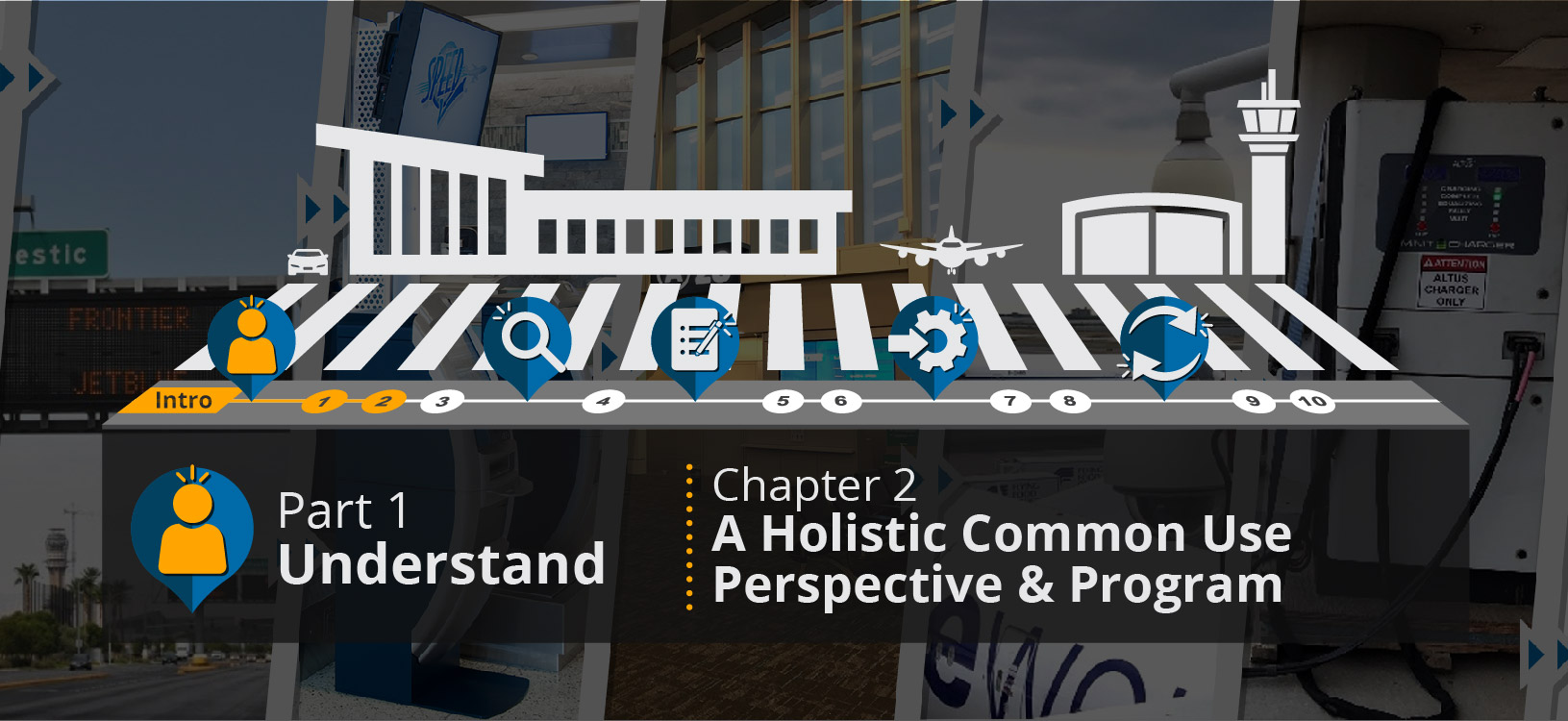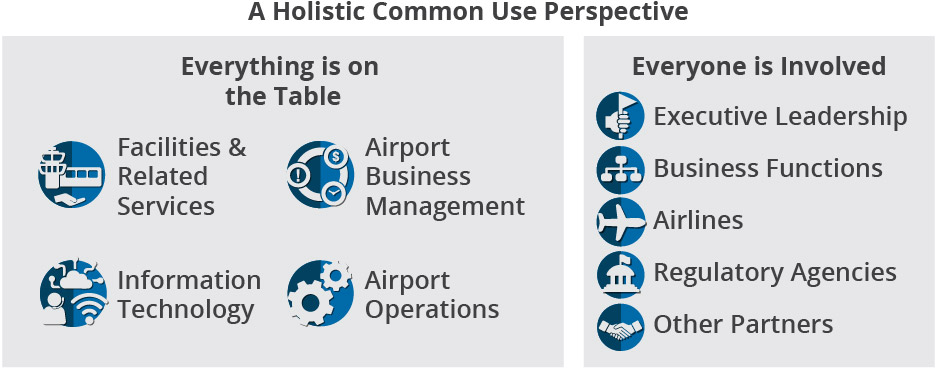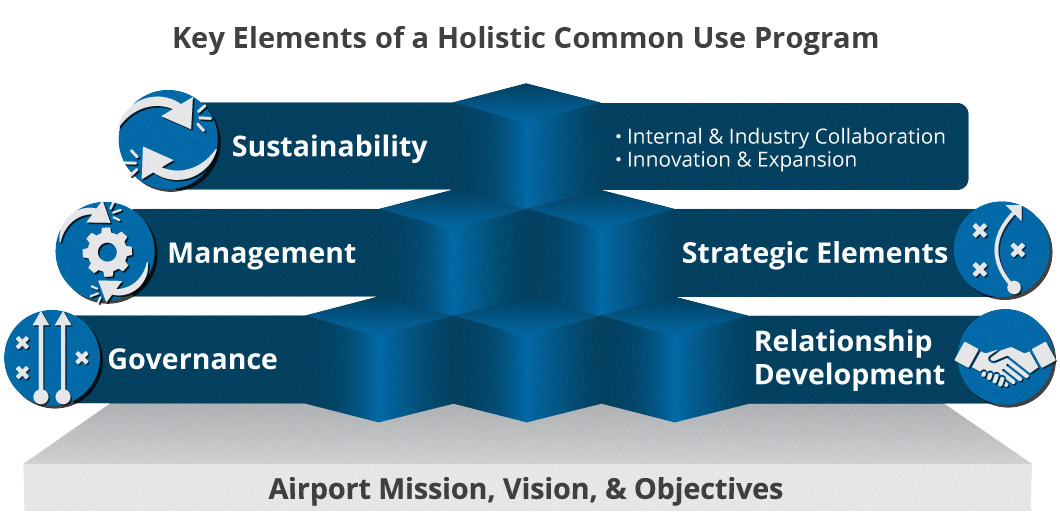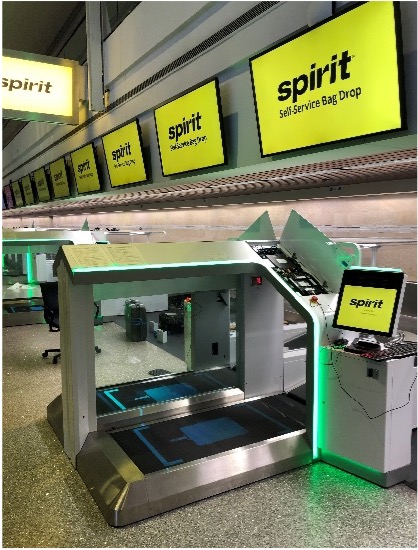
What is a Holistic Common Use Perspective & Program?
The Box of common use has brought an extremely valuable set of capabilities to many airports. However, since the term “common use” has applied to The Box for so long, many have limited the scope and range of their common use program; they have put their Box in the corner as “just something that IT maintains.” The industry needs a perspective change to fully realize the foundationally enabling value of the common use operating philosophy. But even within implementations of The Box, there are opportunities to expand the common use footprint and integrate systems that are only possible when airport operators take a more holistic perspective.
A Holistic Perspective
A holistic common use perspective is one in which everything is on the table and everyone is involved, as shown in Figure 2.1.1.

Figure 2.1.1: A Holistic Common Use Perspective
Everything is on the Table
Taking a holistic common use perspective first involves stepping back to acknowledge facilities, systems, and services that function as common use but are not outwardly acknowledged as such and, therefore, are not considered under a common use program. This includes things like power, phone systems, the airfield environment, building infrastructure, safety systems, management and control systems, and roadways. It then involves opening the aperture to include every element of the airport campus and asking, “Should this be common use?” Things like janitorial services, the network (wired and wireless), signage, cameras, or new services or infrastructure like charging stations for airfield vehicles are all on the table.
It is important to emphasize that a holistic perspective is one that considers all details within each element that might be overlooked. For example, an obvious element such as power/electricity also requires establishing redundancy and protection, where charging stations are placed, and whether they are powered to the degree needed for the stakeholders using it.
If the airport does not provide leadership, these areas will be addressed by someone. This leaves to chance important outcomes in these areas, such as whether they will be done poorly, in silos, or with minimal collaboration between stakeholders. An airport operator with a holistic perspective will take leadership to gather all impacted stakeholders and coordinate the best decision to make things happen in a more considered fashion. Many things will remain common use. Some may need to be transitioned to common use. Others may be best made proprietary to a given stakeholder. Regardless, the airport operator is taking ultimate responsibility for ensuring their airport runs efficiently and serves the customer well.
Everyone is Involved
For this to be successful, the airport operator needs to consider and involve every stakeholder group across the airport's organization matrix and at all levels of functions, such as business, finance, concessions, technology, planning, air service development, and custodial. It then involves those beyond the organization's boundaries, including federal agencies, ground handling companies, law enforcement, fire services, security (physical and cyber), and everything in between. It includes the front-line personnel, such as those monitoring the curbs or cleaning the terminals, all the way up to and including the airport director.
For example, one airport operator installed common use kiosks and flight information display systems but, after a while, realized nobody was cleaning them (something that is especially troubling in the post-COVID era). The problem in this instance was that the airport operator simply did not consider the custodial element for items previously maintained by the airlines. Further, the custodial personnel did not want to simply guess about the proper cleaning processes and materials to use for these common use items.
Bringing a holistic perspective to common use ensures those who would consider these details are brought to the table so that no stone is left unturned.
What a Holistic Perspective is Not
This perspective is not one in which the airport operator dictates every small operational factor and micromanages all stakeholders. This would be ineffective and impractical. The airport operator does not need to own and operate everything; it is simply their role to coordinate activities and ensure that they are happening with the customers and future in mind.
Key Elements of a Holistic Common Use Program
An airport operator with a holistic common use perspective needs an accompanying program to plan and manage common use efforts. Figure 2.1.2 presents the key elements of such a program.

Figure 2.1.2: Key Elements of a Holistic Common Use Program
A holistic common use program starts with governance as part of the foundation, which includes principles, processes, and practices that define the authority and responsibilities necessary to achieve the airport's mission, vision, and objectives. The foundation also includes relationship development through significant collaboration with the airport business units, as well as external stakeholders, such as the airlines, CBP, TSA, concessionaires, and business partners, to fully understand their relevant needs.
Further, it includes strategic elements, such as a strategic plan with specific objectives, a strategy for achieving them, and a high-level roadmap to implement initiatives. This also includes an architecture consisting of business process, information, data, application, and technology architecture layers for effectively and efficiently realizing airport and common use strategies. It also requires an implementation and migration plan to ensure the alignment of individual initiatives with the program and project portfolios.
Finally, it includes management and sustainability elements, including management activities of overseeing implementation, support, and program evaluation requirements. It then includes ongoing stakeholder collaboration with peer airports and industry associations for improved mutual benefit, incorporation of innovation, and expansion of scope, scale, and formality.
Parts 2-5 will provide more detail on each of these areas.




